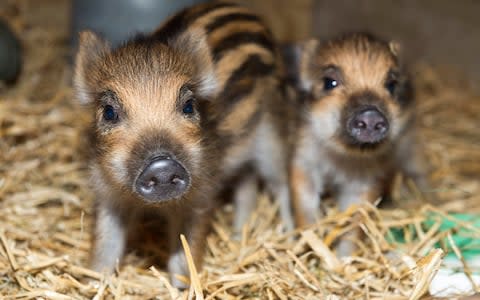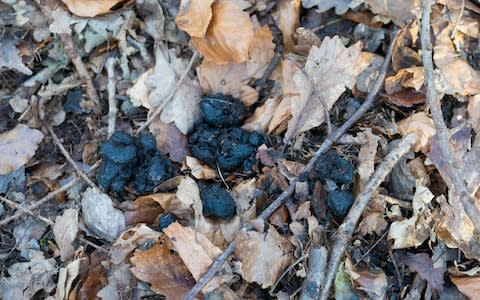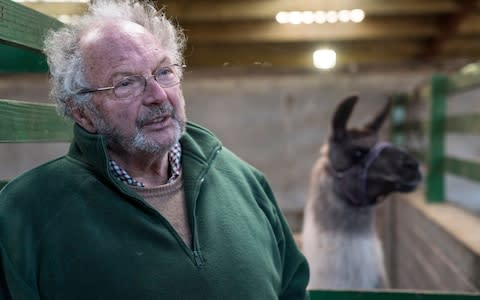Boar war in the Forest of Dean – but what are the animals really like?

“Clive doesn’t harbour any ill-will towards the boar,” says Drew Pratten thoughtfully. We are trudging through the thick mud and dead leaves of the Forest of Dean, which is home to approximately 1,400 of the beasts.
One of those wild boar, presumably still at large, bit a chunk out of Clive Lilley’s finger in January. Lilley, a near-neighbour of Pratten’s, was attacked while walking his dog in the woods near Lydney, Gloucestershire. (Contacted by The Telegraph, Lilley neither confirmed nor denied that he harbours ill-will).
Boar are the lean and hirsute ancestors of the over-bred pink blimps we know as pigs
In Lydney and the villages in the town’s orbit, whether it was a mauling or a nibble or a nip depended mostly on individual residents’ stance on their hairy, grunting interlopers. Human and boar have coexisted here since the late Nineties, when a small number of boar escaped or were illegally released into the forest.
By way of background, boar are indigenous to the British Isles, but are easily hunted. Since the 14th century they have survived only in captivity, never lasting more than a few generations in the wild. This is despite attempts by hopeful noblemen to reintroduce them – albeit for the purposes of chasing them on horseback, rather than in service of biodiversity.

Yet the sounder (for that is the term for a herd of wild swine) that was released into the Forest of Dean multiplied in size, multiplied again, were enhanced by an illegal release in 2004 of another 60 boar, and subsequently splintered into many dozens of sounders. The Forest of Dean’s current population of boar is thought by the Forestry Commission to exceed 1,200. Conditions are perfect: winters have been mild, natural predators have been non-existent, poaching has been infrequent, and, when the boar venture from the dense depths of the forest to the fringes of local towns, they are often rewarded with treats or discarded snacks.
Whether it was a mauling or a nibble or a nip depended mostly on individual residents’ stance on their hairy, grunting interlopers
“They shouldn’t see humans as a source of food,” Pratten says. He blames human feeding for the attack on Lilley. The only other circumstance in which boar might be aggressive, he says, is when they are trying to ward humans away from their young. Even if they’re not very dangerous, though, the boar can be vexing. Pratten and I are walking along a roadside that was once grassy but now looks like a ploughed field, its muddy divots stippled with telltale cloven prints. Boar are foragers, nosing under turf to find tubers and earthworms, and appear to leave no blade of grass untossed. For miles around, the only untouched patches of grass (graveyards, football and cricket pitches) are surrounded by stone walls or wire fences.
Pratten, a genial 49 year-old, says you don’t need to do much to keep the boar out, and that aeration of the soil is good for fauna. Pratten, obviously, is a boar sympathiser, and is part of a group that defends the animals from the culling carried out by the Forestry Commission. Wild boar are classified as feral, and the Commission, aiming to reduce the numbers of the troublesome swine to about 400, has built towers in the forest from which marksmen shoot them.

The Wild Boar Cull Saboteurs, as Pratten’s group is called, argues that the cull is unnecessary and cruel. They suggest that the boar simply be fed contraceptives, a scheme currently being mooted in Belgium, where there is a similarly controversial population. The Commission, however, says it is “not aware of an effective contraception option for the situation in the Forest of Dean”, and is continuing to shoot the boar and sell the carcasses for human consumption.
So the Saboteurs, true to their name, have been sabotaging the cull, toppling the towers and removing bait. Pratten recounts locating a tower on one of his days off work, and sitting beside it all day to ward off nearby boar. The group infuriates supporters of the cull, but has attracted 2,800 followers online and appears to be well-organised and enthusiastic.
Pratten and I walk further into the forest among tall, slim trunks of oak and beech. We are at the top of a knoll whose lower reaches are marshy enough to be enjoyed by muck-rolling boar. They are crepuscular animals, so we’re unlikely to catch sight of any of them this afternoon, but there are more traces by the watering holes: another set of prints, and some dark, glistening droppings.

There are no real life boar in sight, though, so here are some facts instead. Boar are the lean and hirsute ancestors of the over-bred pink blimps we know as pigs. Moving around wooded areas, they forage omnivorously, using their shovel-like snouts to turn over the ground. They live in matriarchal groups of up to several dozen. Adult males, recognisable by size and tusks, strike out on their own, rejoining the sounders in order to woo the sows. A boar’s sense of smell is as good as a dog’s, but its vision is terrible. Fortunately they can communicate articulately, if not mellifluously, through a system of grunts: piglets purr and whine, while adult females grunt. Males are quieter, but in general, boar make high-pitched cries when fighting, and huffing noises when alarmed. In case you’re wondering, the huffing noise was transcribed by Soviet researchers in 1988 as “Ukh! Ukh!”
The boar are loci for various cultural concerns
An important addendum here. How likely is a human to hear those noises? There are stories – which I could not verify – about grandmothers too frightened to leave their homes for fear of being roughed up by gangs of boar. Some dog walkers report being chased; I later spoke to a man who’d got too close to a young litter, and was pursued by four or five boar until he’d regained a safe distance. “They weren’t at full pelt,” the man told me, “but they made me run, I’ll tell you!”. Such are the local tensions regarding the boar that he refused to share his name.
Pratten takes us to meet some unwild boar at a nearby equestrian centre. Alistair Fraser, who runs the centre, has four of them: one male, three female. Two of the females live in a muddy enclosure containing an Anderson shelter. As we arrive, they’re truffling away at the mud, pausing to raise twitching, hairy snouts to us. Their fur has the bristliness of a doormat and their eyes are small and dark. Unconcerned by their hideousness, they happily and endearingly snuffle their way around the enclosure, as indifferent to the mud as a fish is to water. Cute? No. Filthily epicurean? Yes.

Fraser explains that he keeps boar because he likes them and wants to educate people. He takes us into a barn, where another sow, Peppa, is in a pen. A llama in an adjoining pen looks on quizzically. “She’s very tame,” Fraser says. “She sits on people’s laps.” He gives her bristly flank a stroke and leaves her to her thoughts: Peppa is pregnant, nearly due.
I part ways with Fraser and Pratten and collar more locals. They find the boar a nuisance, mostly, but not a menace. They are a part of quotidian life here; they even seem to know what days the bins come out. The boar are loci for various cultural concerns – how should we govern our woodland? How should we treat animals? How do we define what’s natural? – but, like everything in life, from the monstrous to the magical, have eventually become mundane.
As afternoon fades into evening, the photographer and I get back in the car to head home. We’d seen boar, but not wild boar.
Then, as we pass a walkers’ pub – boar! Four of them! Emerging from the undergrowth, they trot regally across the road. We leap out of the car to follow them. They’re glossy and muscular and entirely unperturbed by our presence as they set about the fresh grass in front of the pub. I can see why they were hunted down so easily.

As we take pictures, a four-by-four slows down and its driver rolls down the window. “It’s not a camera you want,” he shouts, “it’s a gun.”


